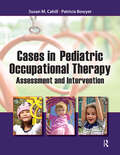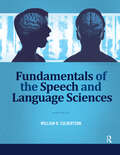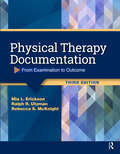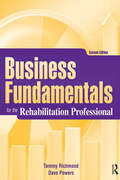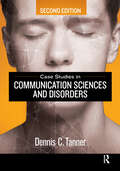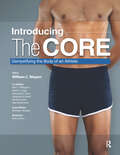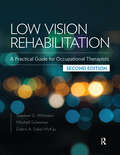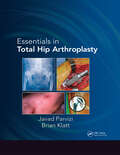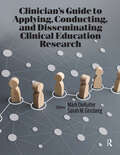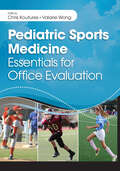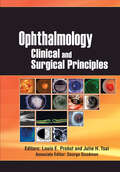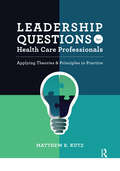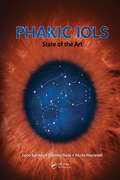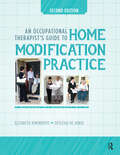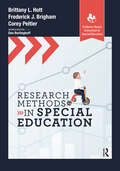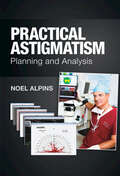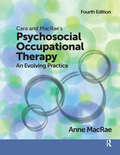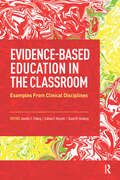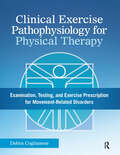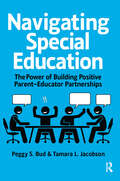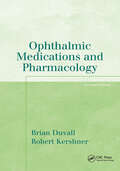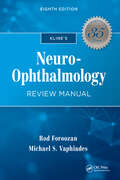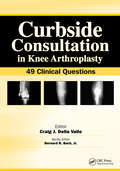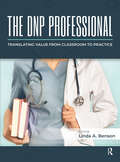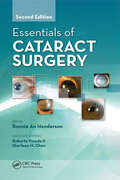- Table View
- List View
Cases in Pediatric Occupational Therapy: Assessment and Intervention
by Susan Cahill Patricia BowyerCases in Pediatric Occupational Therapy: Assessment and Intervention is designed to provide a comprehensive collection of case studies that reflects the scope of current pediatric occupational therapy practice.Drs. Susan Cahill and Patricia Bowyer, along with more than 50 contributors, begin each section with an introduction to the practice setting and direct instructors and students to additional resources for more information. The text includes more than 40 cases that include client overviews, relevant history and background information; information regarding the analysis of occupational performance; information about progress in treatment; and questions to promote the development and refinement of clinical reasoning skills.Cases are presented from various practice settings, including: The neonatal intensive care unit Early intervention School systems Outpatient services Hospital-based settings Mental health settings Community settings Each case included in Cases in Pediatric Occupational Therapy is written by professionals with first-hand experience working with pediatric clients from the specific practice setting, and it aligns with the occupational therapy process represented in the AOTA’s Occupational Therapy Practice Framework, Third Edition. In addition, supplemental information, photographs, and video clips help to bring the cases to life. Included with the text are online supplemental materials for faculty use in the classroom.Cases in Pediatric Occupational Therapy will guide occupational therapy students, faculty, and practitioners through effective clinical decision making during the selection of assessment procedures and the development of client-centered and context-specific intervention plans.
Fundamentals of the Speech and Language Sciences
by William CulbertsonFor a strong foundation upon which to build their futures, students in communication sciences and disorders programs need the best, most up-to-date information available to guide them. To this end, Fundamentals of the Speech and Language Sciences provides a thorough understanding of the core concepts in speech and language while maintaining a readable, engaging tone. Students will be exposed to the fundamentals of acoustics, respiratory science, voice production, acoustic phonetics, and sound spectrography. Language representation and motor programming as they pertain to the dynamic process of speech communication are also explored, as are the fundamentals of speech perception and instrumentation. To give students context, side bars feature the stories of seminal scientists and scholars and their contributions to the topics being discussed. This text benefits from Dr. William Culbertson’s nearly three decades of experience in teaching, as well as another decade of experience as a clinical speech-language pathologist. That experience has honed his ability to clearly communicate these crucial topics in a way that students will understand.Topics covered: The scientific method and various types of research used to study the normal aspects of human speech and hearing The basics of physics as they pertain to energy, motion, displacement, force, and pressure and their relationship to speech production The process of respiration as it pertains to gas compression, speech valving, driving pressure, impedance, and flow Voice onset, modes of vocal vibration, pitch adjustment, volume and quality The process of dynamic interaction representation at the cortical and subcortical levels of the five basic speech processes: respiration, phonation, articulation, resonance, and prosody Undergraduate students in communication sciences and disorders programs, as well as the related programs of music (voice), special education, and speech communication, will value Fundamentals of the Speech and Language Sciences as the formative text for their understanding of the speech and language sciences.
Physical Therapy Documentation: From Examination to Outcome
by Mia Erickson Rebecca McKnight Ralph UtzmanNewly updated and revised, Physical Therapy Documentation: From Examination to Outcome, Third Edition provides physical therapy students, educators, and clinicians with essential information on documentation for contemporary physical therapy practice.Complete and accurate documentation is one of the most essential skills for physical therapists. In this text, authors Mia L. Erickson, Rebecca McKnight, and Ralph Utzman teach the knowledge and skills necessary for correct documentation of physical therapy services, provide guidance for readers in their ethical responsibility to quality record-keeping, and deliver the mechanics of note writing in a friendly, approachable tone. Featuring the most up-to-date information on proper documentation and using the International Classification of Functioning, Disabilities, and Health (ICF) model as a foundation for terminology, the Third Edition includes expanded examples across a variety of practice settings as well as new chapters on: Health informatics Electronic medical records Rules governing paper and electronic records Billing, coding, and outcomes measures Included with the text are online supplemental materials for faculty use in the classroom.An invaluable reference in keeping with basic documentation structure, Physical Therapy Documentation: From Examination to Outcome, Third Edition is a necessity for both new and seasoned physical therapy practitioners.
Business Fundamentals for the Rehabilitation Professional
by Tammy Richmond Dave PowersThe world of business is ever changing, with much of the available information becoming quickly out-of-date. Business Fundamentals for the Rehabilitation Professional, Second Edition keeps pace with this changing world and provides the health care professional with the latest information to answer the “what, where, how, and when” questions that come up when transforming a health care practice idea into a successful business.With this updated Second Edition, Tammy Richmond and Dave Powers take the health care professional to the next level of implementing successful business operations by the introduction of applications of management principles, as well as implementation of evidence-based practice guidelines and basics to billing and coding documentation. Business Fundamentals for the Rehabilitation Professional, Second Edition addresses how to identify emerging business opportunities, legal and health care regulatory issues, market research and development, and health care operations.New features in the Second Edition: New Management and Operations checklist An in-depth look at reimbursement, billing, and financial survival Strategic target market promotions Updated templates and tools Review questions Downloadable worksheets available with text purchase Keeping the user-friendly format of a workbook, Business Fundamentals for the Rehabilitation Professional, Second Edition is the perfect resource for master and doctorate level students preparing for the professional world, as well as rehabilitation professionals and entrepreneurs interested in obtaining knowledge in starting up, managing, expanding, or understanding the health care practice system.What will you learn? How to create a vision and mission statement How to develop a business and marketing plan How to manage finances within the scope of the practice What are your local state and federal regulations What are the small business guidelines
Case Studies in Communication Sciences and Disorders
by Dennis TannerThe discipline of communication sciences and disorders is an exciting field that appreciates the wonders and complexities of human communication. Case Studies in Communication Sciences and Disorders, Second Edition is an informative and relevant text that addresses the myriad disorders, deficits, diseases, and disabilities that can lay waste to the incredible systems involved in communication.Case Studies in Communication Sciences and Disorders, Second Edition by Dr. Dennis Tanner provides engaging factual and historical information about each of the major communication disorders. The case studies presented in each chapter uncover the functional barriers encountered by clients of practicing speech-language pathologists and audiologists. Each chapter provides a scholarly overview of a communication disorder with an emphasis on etiology, diagnosis, and treatment and uses several case studies to illustrate the many different presentations of each disorder. Over 50 case studies reflect true clinical practice and include detailed patient histories that give humanity and depth to the patient-clinician relationship.Chapter Topics in the Second Edition Include: Language delays and disorders Articulation and phonology disorders Stuttering Voice and resonance disorders Aphasia Motor speech disorders Dysphagia Traumatic brain injury Hearing loss and deafness Case Studies in Communication Sciences and Disorders, Second Edition is a relevant and readable text for speech-language pathology and audiology students and clinicians that takes theory and clinical reasoning and applies them to a variety of interesting cases.
Introducing the Core: Demystifying the Body of an Athlete
There is no more important area of the body for an athlete than the core, the region of our body from our chest to our knees. The core is our engine, our hub of activity. Strength there makes life easier for shoulders and knees. It produces speed and explosiveness. Endurance and grit.The core is so important. So why has it remained such a medical mystery?This book will explain that.Introducing the Core: Demystifying the Body of an Athlete traces the arc of the journey from injury to restoration of power to the return to normal life.Dr. William Meyers is the nation’s foremost authority on core health. Along with over 40 world-renowned expert contributors, Dr. Meyers explains how the core functions through stories from his work in locker rooms, the operating room, and the playing fields of elite athletes, giving readers a thorough understanding of the core’s widespread influence on athleticism and the human anatomy.The book: Dissects the events that led Dr. Meyers and his team of experts to their new appreciation of this anatomy Brings multiple world-renowned arthroscopists into the overall core picture, providing their perspectives on how the core works, with the pubic bone as “the sun” of the body’s universe Offers insight into the many causes of pelvic pain, demonstrating why the term “sports hernia,” should be banished forever Emphasizes the fact that a wide spectrum of professionals treat the core -- from traditional surgeons to alternative therapists Brings it all together and proposes a new future, and perhaps a new medical specialty, that is the core “Strength, power, and endurance all flow from the core. This book, and the work Bill Meyers has done in the field, will bring good core health to the forefront and help everyone—elite athletes and others.”—Michael William Krzyzewski“Even in baseball, injury patterns in the shoulder and elbow are related to core imbalance. This book has been needed for a long time… Bill has helped the idea of core strength become more popular, and this book could be what is needed to get it more attention.”—James Rheuben Andrews, MD“To understand the core, you must put on new eyes.” —Marshawn Lynch
Low Vision Rehabilitation: A Practical Guide for Occupational Therapists
by Mitchell Scheiman Stephen Whittaker Debra Sokol-McKayThis Second Edition of Low Vision Rehabilitation: A Practical Guide for Occupational Therapists provides current, evidence-based information on low vision rehabilitation that contains several new and expanded chapters on ADLs, IADLs, and recreation, as well as new online resources and the latest in accessibility devices.Low vision rehabilitation is rapidly growing as a specialty practice for occupational therapists. This growth requires practical, evidence-based information on the evaluation and treatment of the effects of low vision on occupational performance. Responding to this need, Low Vision Rehabilitation: A Practical Guide for Occupational Therapists, Second Edition blends standards of practice that have been developed for over 50 years by low vision therapists and optometrists, with the latest scientific research and the unique perspective of occupational therapists.This text is written to introduce the student and general practitioner to low vision rehabilitation as commonly encountered in medical rehabilitation as well as provides a conceptual approach to evaluation and treatment that will enrich an advanced practice. Authors Stephen Whittaker, a low vision researcher, certified low vision therapist and occupational therapist, Mitchell Scheiman, an optometrist and researcher, and Debra Sokol-McKay, an occupational therapist with specialty certification in low vision as well as certification as a low vision therapist, vision rehabilitation therapist and diabetes educator, have carefully selected evidence-based evaluations and treatments that focus on clinical practicality and meaningful occupational goals in adults.New to the Second Edition: A focus on occupational performance using “whatever works,” whether visual, non-visual, or a combination of these different devices and adaptive techniques The “EPIC” Framework, a general strategy to organize a treatment plan for daily activities using visual and non-visual techniques Access to a companion website designed as a handy clinical reference, with solutions to clinical problems easily searchable and cross-linked to related content The “Success-Oriented Approach” to interventions based on the most recent research on cognitive disability and depression associated with low vision Applications of the latest electronic accessibility devices including smartphones, tablets, and magnifiers that read aloud Incorporates the AADE™ 7 Self-Care Behavior framework of the American Association of Diabetes Educators Incorporates concepts from the latest edition of the AOTA Occupational Therapy Practice Framework: Domain and Process A chapter devoted to field loss, spatial neglect and perceptual impairments resulting from acquired-brain-injury. The latest in Medicare documentation standards including outcome to G-code conversions and ICD-10 diagnostic coding for low vision. Included with the text are online supplemental materials for faculty use in the classroom.Features Included: Recommended practical evaluation and treatment methods such as a 1 hour evaluation protocol, how to write observable and measurable goals and document outcomes, and specific instructions on how to implement treatments Prepares therapists for the ACVREP certification as a low vision therapist or vision rehabilitation or AOTA specialty certification in low vision Emphasizes intervention and low vision rehabilitation treatment including: modification of the environment adaptive visual and non-visual techniques selection and use of non-optical assistive devices selection and use of electronic and optical devices and use of computer technology including smartphones and tablets Comprehensive case studies on vision impairment resulting from eye disease to head injury and more Provides valuable in
Essentials in Total Hip Arthroplasty
by Javad Parvizi Brian KlattEssentials in Total Hip Arthroplasty by Dr. Javad Parvizi is a succinct, yet comprehensive text that provides a unique and colorful look into the world of total hip arthroplasty, an in-depth history of this common procedure, as well as strategies to treat and prevent complications.Inside you will find information on:• Patient selection• Preoperative templating• Surgical techniques• Relevant anesthesia and pain management• Postoperative rehabilitation• Strategies for minimization of complications• Relevant figures and diagrams• And much moreEssentials in Total Hip Arthroplasty is unique in its format to provide basic and detailed information on total hip arthroplasty from A to Z with descriptive, easy-to-read text and extensive visual elements, such as charts and tables.With total hip arthroplasty being the most successful and popular procedure and each chapter being written by both a resident and an attending, Essentials in Total Hip Arthroplasty will be the essential “go-to” text for residents, fellows, physical therapists, students, and junior attendings involved with all matters related to the procedure.
Clinician’s Guide to Applying, Conducting, and Disseminating Clinical Education Research
by Mark DeRuiter Sarah GinsbergClinician's Guide to Applying, Conducting, and Disseminating Clinical Education Research provides clinical educators with the fundamental knowledge to be effective consumers of research and integrate it into their clinical education practice.Clinical educators are routinely called upon to provide early-career clinicians with clinical education and supervision within their practice. Clinician’s Guide to Applying, Conducting, and Disseminating Clinical Education Research fits at the intersection of clinical education and research for the supervising clinician—helping clinicians consider how they might contribute to the scholarship of teaching and learning related to clinical education.This one-of-a-kind text features a multidisciplinary perspective with contributors from various fields in allied health, such as speech-language pathology, occupational therapy, audiology, physical therapy, and more.What’s included in Clinician’s Guide to Applying, Conducting, and Disseminating Clinical Education Research: A hands-on workbook section for clinical educators to apply the content to education and clinical supervision research Chapters on seeking research mentorship, qualitative and quantitative research foundational concepts, and publishing and presenting research Parallels between evidence-based practice and evidence-based education Clinician’s Guide to Applying, Conducting, and Disseminating Clinical Education Research walks the reader through generating research all the way to implementation and dissemination while linking communities of working professionals to their students and research institutions.
Pediatric Sports Medicine: Essentials for Office Evaluation
by Chris Koutures Valarie WongPediatric Sports Medicine: Essentials for Office Evaluation is a clinically relevant reference presented in a question-and-answer format designed to be a primary resource for all pediatric providers and health care professionals who work closely with children or young adults with sports related injuries.Dr. Chris Koutures and Dr. Valarie Wong explore the topics most commonly asked pertaining to pediatric sports medicine, in a casual, yet informative manner. The unique format of this cutting-edge book provides a rapid reference and “quick look-up” for today’s busy practitioner.Pediatric Sports Medicine: Essentials for Office Evaluation includes unique chapters such as key sports medical terms and phrases, how to take a sports medicine history, what imaging studies to order, and how to determine safe return to play for many medical and musculoskeletal concerns.Additional features include:• Information on pediatric sports medicine rehabilitation• Tips on specialty referral• Generous use of tables and figures • Pictures of labeled images and radiographs that highlight key landmarks and points of emphasisWith contributions from many of the experts in the field, Pediatric Sports Medicine: Essentials for Office Evaluation is an easy-to-read resource for any medical practitioner, including physicians, nurse practitioners, physician assistants, residents, medical students, physical therapists, and athletic trainers, and many more, seeking to quickly expand their knowledge of pediatric sports medicine.
Ophthalmology: Clinical and Surgical Principles
by Louis Probst Julie TsaiOphthalmology: Clinical and Surgical Principles is a comprehensive, yet, accessible guide to medical and surgical ophthalmology that succinctly addresses the diagnosis and treatment of all major diseases of the eye. Louis E. Probst, Julie H. Tsai, and George Goodman, along with the 16 world expert subspecialty contributors, have organized the concise, clinically focused, and user-friendly chapters by subspecialty and include the indications, techniques, and complications of common ophthalmic surgical procedures. This attentive chapter organization reflects the way modern-day ophthalmology is practiced.Ophthalmology: Clinical and Surgical Principles delivers practical emphasis, allowing the reader to apply the information into a clinical setting. Residents will additionally benefit from the surgical options discussed for specific disorders. Features:• More than 400 high-quality diagrams, figures, and color photographs.• Diagrams, tables, and figures to facilitate comparisons and assimilation of the information.• References to provide a starting point for further study and research.• Study questions at the conclusion of each chapter to allow readers to test their knowledge and prepare for important examinations.Ophthalmology: Clinical and Surgical Principles is comprehensive and practical enough to be a complete resource for the ophthalmologist, ophthalmology resident, optometrist, as well as family physicians, medical students, and ophthalmic technician.
Leadership Questions for Health Care Professionals: Applying Theories and Principles to Practice
by Matthew KutzLeadership Questions for Health Care Professionals: Applying Theories and Principles to Practice by Dr. Matthew R. Kutz presents some of the most common leadership questions with the intent to facilitate intrigue and dialogue about the general concept of leadership and an awareness of potential leadership issues facing health care professionals.Leadership Questions for Health Care Professionals presents responses that will initiate discussion, as well as offer solutions based on the best available evidence across a wide spectrum of relevant research. Discussion questions at the end of each response will allow the reader to engage in critical thinking and re-evaluate their experiences and offer new insights into their leadership journey.Sections include questions on key issues for health care professionals: The essence of leadership Leadership development Teamwork and communication Change Organizational culture and complexity Leadership ethics and power Diversity and multicultural leadership Leadership Questions for Health Care Professionals takes an interprofessional and interdisciplinary approach and is relevant for athletic trainers, physical therapists, occupational therapists, speech-language pathologists, nurses, physicians, and more.Leadership Questions for Health Care Professionals: Applying Theories and Principles to Practice offers students a broader conceptual understanding of leadership, as well as the depth required by seasoned health care clinicians, managers, and executives who are looking for practical and evidence-based insights to their toughest leadership issues.
Phakic IOLs: State of the Art
by Lucio Buratto Stephen Slade Nicola HauraniehThe surgical correction of refractive vision errors has dramatically and continually changed over time. The evolution of laser vision correction has been aided by advancements in the technology, growing experience, and improved understanding of the eye and its response to surgery. However, not all refractive errors can be treated with the laser. Phakic IOLs: State of the Art is designed to provide the advances in phakic IOL technology and techniques, ideal for physicians who treat many of the patients who are not candidates for laser vision correction. The collaboration of Dr. Lucio Buratto, Dr. Stephen G. Slade, and Dr. Nicola D. Hauranieh, along with a team of international surgeons, has produced a complete book specifically aimed to improve the treatment and therefore the quality of vision of patients. Phakic IOLs: State of the Art is designed for ophthalmologists interested in learning the concepts, developing the skills, and preparing for phakic IOL procedures. This book contains a detailed description of the basic technique of the operations, as well as the special techniques devised by the international contributors. Richly illustrated with over 200 images that demonstrate the various concepts, readers are able to develop a more thorough understanding of phakic IOL implantation. This definitive resource couples both the authors’ and contributors’ diverse experience and knowledge to produce a complete resource of vision correction with phakic IOLs.Expert ophthalmologists interested in being on the cutting edge and enhancing their surgical skills, as well as new physicians, will benefit from adding Phakic IOLs: State of the Art to their personal library.
An Occupational Therapist’s Guide to Home Modification Practice
by Elizabeth Ainsworth Desleigh de JongeOlder people and people with a disability have a right to be included in all aspects of home and community life, and yet, environmental barriers continue to exist in the built environment. There are concerns about how well homes can support older people and people with a disability over time as their needs change.Occupational therapists are well suited to determining the most appropriate home modification solutions to address environmental barriers. They possess the knowledge and skills necessary to evaluate people’s current and future needs in the context of the nature and use of the environment and can work collaboratively with design and construction professionals to develop solutions.To be comprehensive and effective in their approach, occupational therapists need to understand not only the individual’s requirements, but also, the ethical and legal contexts for practice, the technical aspects of the built environment, the relevance and intent of access standards and design approaches, and the application of a range of products and finishes.An Occupational Therapist’s Guide to Home Modification Practice, Second Edition by Elizabeth Ainsworth and Desleigh de Jonge and their team of expert contributors provides comprehensive information to inform occupational therapists about current practice and research. This includes the authors using a transactional approach to examine the person-occupation-environment interaction and providing occupational therapists with a detailed understanding of the various dimensions of the home environment that can impact on client’s home modification decisions.New material has been provided relating to research and practice issues, such as an overview of the latest home modification outcome research findings as documented in literature; an update on outcome evaluation; new research information about the dimensions of the home impacting on decision making; additional information grabrail and ramp prescription; and the inclusion of new case studies illustrating minor and major modification solutions for clients who present with diverse needs. In the Second Edition you’ll find: A detailed understanding of aspects of the home environment that impact home modification decisions A review of legislative environment and funding systems that facilitate service delivery An overview of home modification services, as well as future trends A range of comprehensive case studies — illustrated by photographs Additional theory to inform knowledge, and skill development, that can be used in home modification practice worldwide Included with the text are online supplemental materials for faculty use in the classroom..An Occupational Therapist’s Guide to Home Modification Practice, Second Edition provides a range of resources and tools, and it can be used as a teaching aid to support students, interns, and novice therapists or as a manual for reflection and practice for more experienced home modification practitioners.
Research Methods in Special Education (Evidence-Based Instruction in Special Education)
by Brittany Hott Frederick Brigham Corey PeltierResearch Methods in Special Education equips readers with the knowledge needed to make a difference with data. Authors Drs. Brittany L. Hott, Frederick J. Brigham, and Corey Peltier provide access to cutting edge methodologies and related skills researchers need to successfully carry out projects in applied settings. Dedicated chapters focusing on quantitative research synthesis (e.g., meta-analysis, meta-synthesis), single case design, and program evaluation methods allow readers deeply invested in the field of special education to develop a firm foundation, enabling them to ask and answer their socially significant research questions.Written for students in special education teacher prep programs, early career faculty, school administrators, and curriculum specialists, this text includes numerous features that set it apart from other available resources: Dedicated chapters on ethics, establishing effective research partnerships, and evidence-based practice Cutting-edge program evaluation methods and reporting Comprehensive coverage of methods commonly used in special education Detailed information on securing special education funding Case studies, exemplars, resources, and recommendations for additional reading Included with the text are online supplemental materials for faculty use in the classroom. YouTube videos featuring interviews with authors The up-to-date research practices in this text are a valuable addition for educators and researchers serving students with disabilities who have a responsibility to support in-school and post-school outcomes. Research Methods in Special Education gives educators the tools to facilitate a deeper understanding of the research process and evidence-based practice.
Practical Astigmatism: Planning and Analysis
by Noel AlpinsThe surgical correction of astigmatism is the last frontier to optimizing visual outcomes for patients. Practical Astigmatism: Planning and Analysis is a comprehensive guide to correcting astigmatism from pre-operative planning to post-operative analysis. This provides readers with unique insight to what actually happened surgically: did the astigmatism over or under correct? Was it on-axis or off-axis? With this book, ophthalmologists will be able to analyze previous procedures with the appropriate nomograms and more often achieve targeted outcomes. Dr. Noel Alpins has developed the Alpins Method of astigmatism to provide accurate planning and analysis of astigmatism procedures. His method focuses on analyzing refractive and corneal astigmatism parameters and using the results in future surgery to improve visual outcomes. The importance of the ocular residual astigmatism (ORA) is detailed when planning astigmatism surgery.Practical Astigmatism features vector planning for refractive laser surgery as well as planning and analysis applied to cataract and limbal relaxing incisions, , in addition to demonstrating graphical analysis of astigmatism using high quality vector and fan diagrams, as used in scientific journals. In addition, hemidivisional analysis of the irregular cornea, corneal coupling in incisional and excimer laser surgery for mixed astigmatism and toric IOL planning with total corneal power using corneal topographic astigmatism (CorT total) are addressed as well.Some Questions Answered Inside: What is the difference between regular and irregular astigmatism? How do I diagnose each, and how does this affect my surgical technique? Can I incorporate corneal astigmatism when performing excimer laser surgery? Why are my LRIs undercorrecting the astigmatism? Is it safe to perform excimer laser on keratoconous patients? Which corneal astigmatism measure do I choose and what do I do following a refractive surprise? Practical Astigmatism: Planning and Analysis will help ophthalmologists, optometrists, and technicians alike address each patient’s unique circumstances and act as your in-depth guide to correcting astigmatism.Testimonials… “For more than three decades I have been listening to, arguing with, and admiring the work of Dr. Noel Alpins in the field of astigmatism. Despite his remote location on the small island of Australia, his knowledge of astigmatism is at the peak of Mt. Everest. There are few others who have devoted their careers to understanding and managing astigmatism for which the world of ophthalmology is truly grateful.” - Robert H. Osher, MD “Noel is an original thinker who took on and conquered the complexities of astigmatism analysis, publishing the seminal papers on the way. His work has formed the cornerstone from which our current understanding and management of astigmatism has been built. He is someone from whom we have all learnt a great deal and this book is a testament to this.” - Dan Z Reinstein, MD MA(Cantab) FRCSC DABO FRCOphth FEBO
Cara and MacRae's Psychosocial Occupational Therapy: An Evolving Practice
by Anne MacRaePhilosophical principles of recovery and justice are driving changing attitudes in the behavioral health arena, but the practical methods used to incorporate these principles needs further clarity. To address this need, Cara and MacRae’s Psychosocial Occupational Therapy: An Evolving Practice,Fourth Edition is completely revised and reorganized. Relevant information from previous editions, including assessments, techniques, diagnoses and specialized programs are interwoven throughout the text with a new emphasis on social issues and lived experiences. Dr. Anne MacRae designed this Fourth Edition to meet practice challenges as the occupational therapy profession continues to evolve to meet the current needs of our communities. It includes specific examples of programs, groups, assessments, activities, techniques, approaches, and outcomes. Inside Cara and MacRae’s Psychosocial Occupational Therapy: An Evolving Practice, Fourth Edition: All new chapters on philosophical worldviews, psychiatric institutions and hospitals, community behavioral health services, and direct service provision, as well as consultation and program development. Reorganized and expanded chapters on built, virtual and natural environments, as well as cultural identity and context. A new chapter on personal and social identity discusses the aspects of identity that are linked to mental wellness/illness including personal choice, family, roles and habits, spirituality, rituals and traditions, as well as the profound effects of trauma, stigma, poverty, and violence. Trauma, stigma, poverty and violence are also identified throughout the text, especially in the case illustrations. Revised chapters on mental health of infants, children, adolescents and older adults. New chapters on mental health of emerging adults and mid-life adults. Instructors in educational settings can visit www.efacultylounge.com for additional materials to be used in the classroom. While occupational therapists can certainly use this material for providing direct services and being part of a team, Cara and MacRae’s Psychosocial Occupational Therapy: An Evolving Practice, Fourth Edition is also an invaluable resource for defining and explaining psychosocial occupational therapy, and in supporting our roles in consultation and program development.
Evidence-Based Education in the Classroom: Examples From Clinical Disciplines
by Jennifer Friberg Colleen Visconti Sarah GinsbergEvidence-Based Education in the Classroom: Examples From Clinical Disciplines shows educators how to use evidence to inform teaching practices and improve educational outcomes for students in clinically based fields of study.Editors and speech-language pathologists Drs. Jennifer C. Friberg, Colleen F. Visconti, and Sarah M. Ginsberg collaborated with a team of more than 65 expert contributors to share examples of how they have used evidence to inform their course design and delivery. Each chapter is set up as a case study that includes: A description of the teaching/learning context focused on in the chapter A brief review of original data or extant literature being applied A description of how evidence was applied in the teaching/learning context Additional ideas for how evidence could be applied in other teaching/learning contexts across clinical disciplines Additional resources related to the pedagogy described in the case study (e.g., journal articles, books, blogs, websites) Educators in the fields of speech-language pathology, audiology, nursing, social work, sports medicine, medicine, dietetics, dental assisting, physician assisting, radiology technology, psychology, and kinesiology—already familiar with evidence-based practice—will find this resource helpful in implementing evidence-informed approaches to their teaching.While the content in clinical programs is quite different, there are many similarities in how to teach students across such programs. Evidence-Based Education in the Classroom: Examples From Clinical Disciplines highlights these similarities and represents a masterclass in how to practice evidence-based education.
Clinical Exercise Pathophysiology for Physical Therapy: Examination, Testing, and Exercise Prescription for Movement-Related Disorders
by Debra CoglianeseIn order to effectively examine, test, and treat patients with exercise, physical therapists need to understand how physiology from the cellular to the systems level provides the basis for normal responses to exercise. But that is not enough. Knowledge about pathophysiology, the changes that lead to abnormal responses to exercise in different patient populations, is also essential. Clinical Exercise Pathophysiology for Physical Therapy: Examination, Testing, and Exercise Prescription for Movement-Related Disorders is a comprehensive reference created to answer the “why” and the “how” to treat patients with exercise by offering both comprehensive information from the research literature, as well as original patient cases.Dr. Debra Coglianese, along with her contributors, have arranged Clinical Exercise Pathophysiology for Physical Therapy into three parts: foundations of physiological responses, pathophysiology of deconditioning and physiology of training, and pathophysiology considerations and clinical practice. The chapters present the physiology and pathophysiology for defined patient populations consistent with the American Physical Therapy Association’s Guide to Physical Therapy Practice.Patient cases also supplement each chapter to illustrate how understanding the content of the chapter informs physical therapy examination, testing, and treatment. The patient/client management model from the Guide to Physical Therapy Practice defines the structure of the patient cases, and the International Classification of Function, Disability, and Health (ICF) model of disablement has been inserted into each patient case. Highlighted “Clinician Comments” appear throughout each patient case to point out the critical thinking considerations.Included with the text are online supplemental materials for faculty use in the classroom.Clinical Exercise Pathophysiology for Physical Therapy: Examination, Testing, and Exercise Prescription for Movement-Related Disorders is a groundbreaking reference for the physical therapy student or clinician looking to understand how physiology and pathophysiology relate to responses to exercise in different patient populations.
Navigating Special Education: The Power of Building Positive Parent-Educator Partnerships
by Peggy Bud Tamara JacobsonThis timely and innovative roadmap for parents, educators, and administrators highlights the importance of effective communication methodology, appropriate correspondence, and data collection recommendations. Effective communication is often missing from the IEP team’s conversation. Navigating Special Education provides a foundation for building proactive, positive partnerships that will lead to 21st century best practices for children.The 5-C Model of Communication—Conversation, Collaboration, Cooperation, Compromise, and Consensus—presented in Navigating Special Education helps to forge trusted alliances between school districts and families.Navigating Special Education draws upon the authors’ 60-plus years of combined experience by using: Anecdotal, evidence-based, real-life scenarios Templates for letter writing and extensive data collection A user-friendly appendix and glossary As stakeholders, wouldn’t you like to have successful meetings where everyone’s voice is heard, respected, and understood? After reading Navigating Special Education, families, educational professionals, college students, and special education organizations will be able to implement effective models of communication and build positive partnerships.
Ophthalmic Medications and Pharmacology (The Basic Bookshelf for Eyecare Professionals)
by Brian Duvall Robert M. KershnerFor those who are new to the subject, ocular pharmacology can be a difficult and sometimes overwhelming topic. Ophthalmic Medications and Pharmacology, Second Edition is a reader-friendly guide that provides a quick review and basic clinical reference of ocular pharmacology.In this updated and revised second edition, Drs. Duvall and Kershner present an overview to the medication and drugs found most commonly in ophthalmic practice without overwhelming those professionals new to the subject. Ophthalmic Medications and Pharmacology concisely reviews commonly used and prescribed medications, how they work, dosage, therapeutic use, and potential side effects. This new edition also highlights key information for patients about the medications they encounter and are prescribed in the clinic.Ophthalmic staff, students, and research professionals looking for an introduction and basic go-to guide will welcome having a copy of Ophthalmic Medications and Pharmacology by their side.New to this edition:· An appendix focused on the drug approval process.· A chapter on retinal therapies.· Study icons to assist in the learning process.· New coverage of vasoconstrictors.
Kline's Neuro-Ophthalmology Review Manual
by Rod Foroozan Michael VaphiadesFor over 35 years, Kline’s Neuro-Ophthalmology Review Manual has presented a unique and user-friendly approach to address clinical neuro-ophthalmology principles used in everyday practice. This Eighth Edition continues that tradition, providing a timely update, while also maintaining the same user-friendly and concise format. Dr. Rod Foroozan and Dr. Michael Vaphiades have taken the mantle of updating this respected manual from Dr. Lanning Kline and continue his tradition of a simple summary of the most important clinical aspects of neuro-ophthalmology with schematic illustrations and material relevant to everyday practice. They are joined by their contributing authors, all seasoned neuro-ophthalmologists, and have organized the book to provide the essential key information on neuro-ophthalmic disorders. The Eighth Edition provides a comprehensive update to the latest information, adds many new effective exercises for case study, and is a complete update on neuro-ophthalmic conditions, including results of recent clinical trials and emerging literature. Also new is the inclusion of a table of neuro-ophthalmic emergencies which serves as a quick guide so that these potentially life-threatening and blinding conditions can be accessed easily.Chapters include: Nystagmus and Related Ocular Oscillations Myasthenia and Ocular Myopathies Nonorganic Visual Disorders Disorders of Higher Visual Function Neuroimaging Kline’s Neuro-Ophthalmology Review Manual, Eighth Edition has all the fundamentals presented logically for all practitioners and residents in ophthalmology, neurology, and neurosurgery. A popular choice among colleagues for more than 35 years, this a must-have resource in neuro-ophthalmology.
Curbside Consultation in Knee Arthroplasty: 49 Clinical Questions (Curbside Consultation in Orthopedics)
by Craig J. Della ValleAre you looking for concise, practical answers to those questions that are often left unanswered by traditional knee arthroplasty references? Are you seeking brief, evidence-based advice for complicated cases or controversial decisions? Curbside Consultation in Knee Arthroplasty: 49 Clinical Questions provides quick answers to the thorny questions most commonly posed during a “curbside consultation” between orthopedic surgical colleagues.Dr. Craig J. Della Valle has designed this unique reference which offers expert advice, preferences, and opinions on tough clinical questions commonly associated with knee arthroplasty. The unique Q&A format provides quick access to current information related to knee arthroplasty with the simplicity of a conversation between two colleagues. Numerous images, diagrams, and references are included to enhance the text and to illustrate the management of the knee.Curbside Consultation in Knee Arthroplasty: 49 Clinical Questions provides information basic enough for residents while also incorporating expert advice that even high-volume clinicians will appreciate. Practicing orthopedists, orthopedic residents, and non-physician personnel will benefit from the user-friendly and casual format and the expert advice contained within.Some of the questions that are answered: I have a patient who has a deformity of the distal femur and arthritis of the knee. Should I do an osteotomy to correct the deformity? If I am doing a total knee arthroplasty and the patella does not seem to track well, what should I do? I am doing a total knee in a patient with a varus deformity. I have done my standard release and the knee is still tight medially. What should I do? What do I do if I cut the MCL intra-operatively? How do you assess joint line position at the time of revision TKA? What are the clinical consequences if it is elevated?
The DNP Professional: Translating Value from Classroom to Practice
by Linda BensonThe DNP Professional: Translating Value from Classroom to Practice is a collection of exemplars from DNP (Doctor of Nursing Practice) -prepared experts across various advanced practice nursing roles and settings. The content illustrates the application of the American Association of Colleges of Nursing’s “Essentials,” quantifies successful DNP-prepared practitioner outcomes, and describes the overall impact of the nursing practice doctorate. Each chapter is written by a different expert and focuses on how the Essentials relate to that author’s role, including business planning, evidence-driven decision making, data analytics, and interprofessional collaboration. These leaders demonstrate how to implement lessons learned in a DNP program and translate them into everyday practice in every nursing domain, with plenty of pearls to pass along. Editor Linda A. Benson has divided the book into sections based on roles and settings: • Nurse Practitioner • Clinical Nurse Specialist • Certified Registered Nurse Anesthetists • Nurse Midwife • Nurse Executive • Academia • Population Health • Informatics • Legislative Activity When performing at their peak, DNPs can affect clinical, satisfaction, and cost outcomes, as well as provide preceptorship and mentoring. With exemplars from across the continuum of practice sites and roles, The DNP Professional: Translating Value from Classroom to Practice enables both students and DNP graduates to optimize the curricular Essentials in the practice setting.
Essentials of Cataract Surgery
by Bonnie HendersonThe straightforward, concise, and easy-to-read reference manual which is equivalent to having the best instructor offering guidance on what to do next and how to avoid potential complications is now available in an updated Second Edition.Essentials of Cataract Surgery, Second Edition comprehensively details every step of phacoemulsification cataract extraction surgery, from preoperative evaluation to intraoperative instruction to postoperative care. The basic elements of cataract surgery are presented in a clear and easy-to-read format.Dr. Bonnie An Henderson brings together advice and teaching techniques from the Harvard Intensive Cataract Surgical Training Conference at the Massachusetts Eye and Ear Infirmary. The book provides both beginning and practicing surgeons with personal tips and expert advice from leading cataract mentors of top US ophthalmology residency programs. Inside Essentials of Cataract Surgery, Second Edition are detailed chapters covering fluidics, IOL calculations and design, capsular complications and management, and the latest phaco technology, including femtosecond cataract surgery. Each chapter contains a summary box, highlighting the key points of each topic discussed. Additionally, the included images, diagrams, photographs, and tables enhance understanding of specific topics.With detailed information and expert pearls in a user-friendly format, Essentials of Cataract Surgery, Second Edition is perfect for residents, fellows, medical students, and practicing ophthalmologists looking to improve their surgical techniques.
